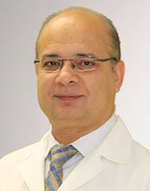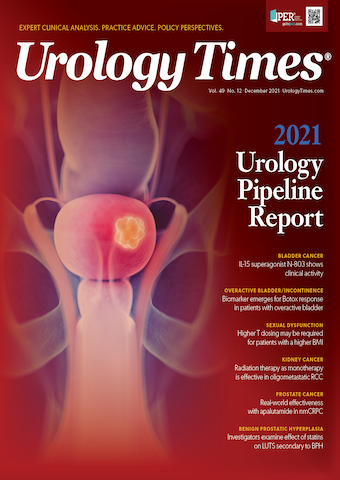Publication
Article
Urology Times Journal
Transrectal vs transperineal biopsy: Comparable outcomes and QoL
Author(s):
"It appears that the TR and TP biopsy procedures are essentially comparable in various aspects of the procedure," writes Badar M. Mian, MD.
Badar M. Mian, MD

Transrectal ultrasound–guided prostate needle (TR) biopsy has been the gold standard for the diagnosis of prostate cancer for nearly 3 decades. More recently, transperineal prostate (TP) biopsy has been gaining popularity because of possible improvement in postbiopsy complications, especially infections. However, studies have reported variable results that largely suggest that both biopsy techniques are quite comparable in their diagnostic and complications outcomes, except for pain during the procedure, which is often worse during the in-office TP biopsy. However, other short-term effects on quality of life related to these procedures (or tests) have not been studied in detail between the TR and TP procedures.
To measure the differences in the test-related quality of life between the 2 biopsy procedures, Shankar et al conducted postbiopsy surveys of men undergoing ultrasound-guided TR or TP biopsy.1 They included men undergoing an in-office, ultrasound-guided prostate biopsy, without MRI guidance or MR-ultrasound fusion, and without any history of Gleason score 7 or higher cancer.Over 77% of patients were biopsy-naïve.
Patients were recruited for participation in the study before the biopsy at 7 clinics, and 161 patients agreed to be contacted for the postbiopsy survey. Of these, 120 (60 TR, 60 TP) patients eventually completed the survey whereas the remainder either declined to complete the survey or could not be contacted. Biopsies were performed by 7 urologists, including some performing only the TR or the TP procedure. Average age of patients was 64.5 years, 81% were white, and 62% had a college degree. Most patients were biopsy-naïve, including 80% in the TR and 75% in the TP cohort.
The authors used 2 main survey instruments during the phone interview, including Testing Morbidities Index (TMI) and Short-Form 12 version 2 (SF-12). The TMI includes several domains including pain and anxiety before and during the procedure, embarrassment during the procedure, and any mental or physical impact the procedure. The mean baseline self-reported physical health, as determined by the SF-12 physical component score, were similar for both groups (TR: 50.6 [SD ± 9.8]; TP: 52.3 [SD ± 8.5]). Similarly, there was no difference in the mean baseline self-reported mental component scores between the TR and TP cohorts. The phone interviews to assess TMI were conducted 1 to 5 days after the biopsy (mean, 1.3 days).
The mean summary testing-related health utility score (scale: 0-1, where 1=perfect baseline health) was 0.86 (95% CI 0.84-0.88) for TR biopsy and 0.83 (95% CI 0.81-0.85) for TP biopsy (P = .08). The only significant difference in the individual domain-level scores (scale: 1-5, with 1 = no health impact, 5 = extreme health impact), was related to more pain during TP biopsy (TR 2.3, 95% CI 2.1-2.4; TP 2.9, 95% CI 2.6-3.1; P = .0002). There were no significant test-related differences in other domains during the biopsy procedure. The overall cancer detection (52% and 53%) and high-grade cancer detection rates (23% and 20%) appeared similar between the TR and TP procedures, respectively. The complications rates, including hospitalizations and infections, were also similar between the TR and TP cohorts.
The temporary testing-related health impact between TR (86% of “perfect” health) and TP biopsy (83% of “perfect” health) were clinically and statistically similar, except for pain during the procedure, which was more painful for those undergoing TP biopsy.
It is not clear why the authors excluded patients undergoing MRI-US fusion biopsy and patients with prior biopsy with Gleason score higher than 6. The goal of the study was to evaluate procedure-related effect on short-term quality of life, which is not likely to be affected by the histology. Conversely, the image fusion targeted biopsy procedures take longer to complete than TRUS biopsy and thus, could have affected the patient experience during the procedure.
The study had a relatively small sample size and patients were not randomly assigned to TR or TP biopsy procedures. It’s possible that patients may have elected or favored 1 procedure over the other, and thus were more accepting of the procedure-related adverse experience. Similarly, the urologists with expertise and/or experience with exclusively performing TP biopsies could have mitigated any potential difference in patient experience between the 2 procedures.
It appears that the TR and TP biopsy procedures are essentially comparable in various aspects of the procedure. If the cancer detection rates, and complications including infection rates, and procedure related-effect on quality of life are similar, how does one recommend 1 procedure over the other to the patients? Despite our best efforts, the non-randomized study design can introduce a number of confounders that can affect the results. There are ongoing randomized control trials that should provide us with essential, high-quality data to inform the discussion regarding TR vs TP prostate biopsy.
Reference
1. Shankar PR, Ellimoottil C, George AK, et al. Testing-related health impact of transrectal and transperineal prostate biopsy as assessed by health utilities. J Urol. 2021;206(6):1403-1410. doi:10.1097/JU.0000000000002118
































